|
I have recently discovered "fire churning" or "churning of fire" which is a friction fire method in India, similar to strap drill made from the Banyan tree, and it seems to be specifically for use during Hindu Vedic fire rituals. There is also the variation of the "fire churn" which seems to have been used in Celtic and Northern European traditions, e.g creating Need Fire which I talk about in these posts: Samhain; Neid Fire
This post focusses on the Fire Churn used within the Hindu religion. The fire sticks are also called the Arani. The Fire Churn is also known as the Agni Manthan by some. The Banyan tree is significant and seems to be the only wood that these are made of. I'm only just learning about this, so I apologise if I get any of this confused, and I welcome any feedback\corrections. From my searches and limited understanding, it seems the Fire Churn may be used in different "strands" of Hinduism but seems to be primarily used in the Hindu religion for the the "invocation" of Lord Agni (Fire.) In some Hindu symbolism, Agni's parents are said to be the two Arani used to start the fire, and when young Arani was said to be cared for by ten servants who are represented by the ten fingers of the man who starts the fire. There is also belief that he is the son of two mothers, the two Arani which are female (in Sanskrit the gender of Arani is female.) The Arani were made from the banyan tree.
From "HOW TO PREPARE HOMA YAGNYA FIRE AGNI MANTHAN PROCESS" :
"Fire (Agni) is the primary God in Vedas and the Agni is to be prepared manually using Banyan twigs/logs ,chanting Agni Suktham. The lighting of the Havan Agni with the churning (Manthan) of the special instrument (Agni Manthan) made from a banyan tree, is considered extremely auspicious. A participant said it required a lot of effort and that is why it is generally not used. It took them about 15 minutes to get it going. ... Preparing Homa, Yagnya fire with Camphor as is being practiced now is incorrect."
From an article in the "Hindu" :
"The ‘Yaga Karta' (chief performer of the yagam) Kapilawai Ramakrishna Sastry and other ‘ritviks' (officiating priests) made the holy fire using ‘Arani Manthani', an instrument similar to a hand drill. While chanting Vedic hymns, they vigorously drilled a wooden shaft. The spinning caused black dust to form near the hole of the soft wood. The black dust with smoulder was transferred onto tinder of twigs. As soon as the flames emanated from the plate of twigs, the environs echoed with the words ‘Harom Hara'.“It is Vedic procedure to make fire with Arani Manthani. We can call it as ‘Agni Madhanam' (churning of fire). It is done with ‘Agni Prathisthana' mantras,” explained P. V. Suryanarayana Sarma, principal of the Vedic School run by the temple. "
So with Fire Churning, it is not about how quick the fire is produced or how easy but it is the ritual of producing the fire and the significance of the materials used (in this case Banyan wood) and the chants and songs that go with it.
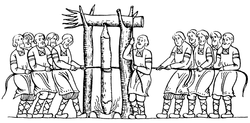 In my various googlings researching into the use of friction fire in ritual, I came across the ritual of Force Fire also called Need Fire, Neid Fire and Teine Eigin or Teine-éiginn (Gaelic for friction fire.) Force Fire seems to have been a ritual within the Celtic tradition and also within other Northern Hemisphere traditions including the Vikings. Force Fire seems to have been a ritual way of starting fires as part of ceremonies (e.g. Samhain and Beltaine Celtic Festivals) but also as a way to cure ills - for example: when your cattle came down with foot and mouth, or other times of distress. It may also have been use by the Norse for lighting funeral pyres. In all these instances, all fires within the local community would be extinguished and a new communal fire would be lit by means of friction (by using a device similar to the one pictured.) Once the new fire had been lit and offerings made, then everyone in the community would light their fires from the new communal fire. In the case of curing ills, damp wood would be added to make copius amounts of smoke and the cattle\people would be paraded through the smoke to "cleanse" them. or in other accounts water is boiled on the fire and then sprinkled over the people\animales. The community would also take a brand from the fire and re-light their hearth fires after the ceremony. It seems different communities would have slightly different rituals, requiring a certain amount of people involved in making the fire, or the fire having to be made in a particular depending on local beliefs and superstitions. It seems this tradition occurred as recent as until the mid 1800s in Scotland. There have been a few written descriptions of the device used to make Force Fire and in the main it sounds like an over-sized Strap Drill, like the ones in the pictures. The one in the above picture wouldn't really work, the reconstructions below are modern working interpretations. First off, it may seem a cumbersome, over engineered, ineffective way of producing fire in comparison to the bow drill and hand drill but that was probably the point, and I'm guessing it was supposed to take many people to "force" fire through this contraption as part of the ritual. I would love to have a go at building one of these. I have made a small model version, but haven't yet fully tested it.
As part of this "project" I'm collecting stories, myths and legends of the origins of fire, there are many out there, and many variations of similar stories within the same cultures and different cultures. Common themes also run through many of the stories, such as fire being hidden away in trees and it can only be released through friction. I plan to collect as many stories as possible and validate each one. This is my list so far of stories , but I'm sure there are many more out there. I have not yet found any from Celtic traditions. Australian Aboriginal:
Crocodile took the fire stick How the Wongaibon obtained fire How the Kamilaroi acquired fire Water rat and fire ... and many more India - Hindu : Rig Veda (3:9.5), the hero Mātariśvan recovered fire through friction Judaism - In the Book of Enoch, the fallen angels and Azazel teach early humanity to use tools and fire. Chinese - Sui Drilling Wood to make fire Greek - Prometheus stole fire and hid it in a fennel stalk Africa - The San of South Africa believe that Ostrich guarded fire under his wing until a praying mantis stole it. and many more Bumba showed the people how to make the firedrill South America Indians of the Amazon River basin in - Aboy stole a hot coal from the Jaguar's fire Pacific Legends in the Caroline Islands of the Pacific link fire to Olofat, a mythical trickster hero Maori\Polynesian - How Maui brought fire to the world Native American How Coyote Stole Fire Cherokee - Grandmother Spider According to some Yukon First Nations people, Crow stole fire from a volcano in the middle of the water. According to the Creek Indians, Rabbit stole fire from the Weasels. In Algonquin myth, Rabbit stole fire from an old man and his two daughters. In Ojibwa myth, Nanabozho the hare stole fire and gave it to humans. and many more Norse\Viking - The Theft of Fire by Loki The Myths of the Origins of Fire by James Frazer contains many stories from around the world including Tanzania, New Guinea, Indonesia, Malaysia, Madagascar, South America, Central & North America, Pacific/Polynesia, Australia It seems that sparks of possibilities born from my practice of friction fire are flying everywhere! Ideas have started to zip zap through my mind recently, so thus I have decided (prompted by my beautiful wife) to blog about it. Sacred Hearth Friction Fire seems to be evolving. I have ideas, lots of them, and so lets see what unfolds over the next few months \ year as this is fitted in between work and family life. I had an idea to maybe write a book the other day so started some research, and have started discovering some very interesting myths, stories, articles and books, which made me realise that this could take some time! I can get rather obsessed at times and throw myself in but some restraint , structure and order will be required. My idea is to bring together origin of fire legends, the sacredness of fire, how fiction fire is still practiced by indigenous peoples today and practical information on friction methods maybe. There is a lot of information out there, and I wish to validate\cross-check as I go so time will be needed. So I may focus on topic by topic and blog about it as I go.
I was looking to see if there was anything similar already out there and came across "Myths of the Origin of Fire: An Essay by Sir James George Frazer" from the 1930s. It seems that this will be very useful in my research, of a place to start and to start cross-checking\validating. I don't like the language used to describe our ancestors and indigenous peoples and it reminds me of how badly indigenous peoples have been viewed and treated - and still are today (and one reason why I support Survival International." ) However, it will still be a very useful tool, and I'm trying to get my hands on a real copy rather than just the ebook - but they aren't cheap! I've also come across some very interesting information regarding ceremonial use of friction fire in different traditions and also the comparison of friction fire with the divine coupling of male and female.. So there is a lot out there to cover..... I just need to structure myself! All very exciting. Also, at some point in the future I would love to hold a "workshop" around fire, ritual and story. Encompassing the ritual lighting of fires using friction fire, weaving in stories and the practical teaching of friction fire but in a sacred way with awareness. For now, I will just start to gain experience by continuing my practice and gaining knowledge, holding demonstrations of friction fire, supporting people I know on their workshops, and gaining experience through my involvement with Spirit Horse. Exciting time ahead..... |
Archives
January 2024
Categories
All
|
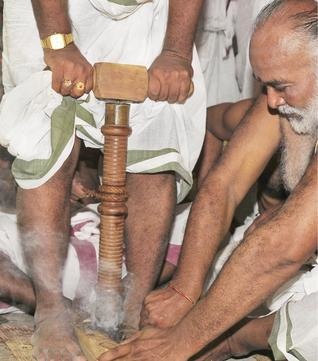
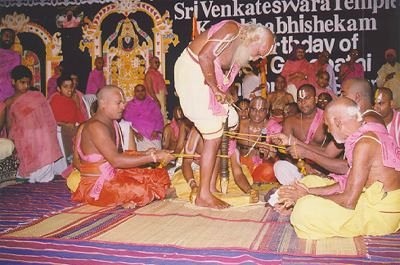
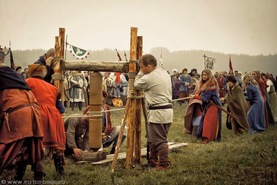
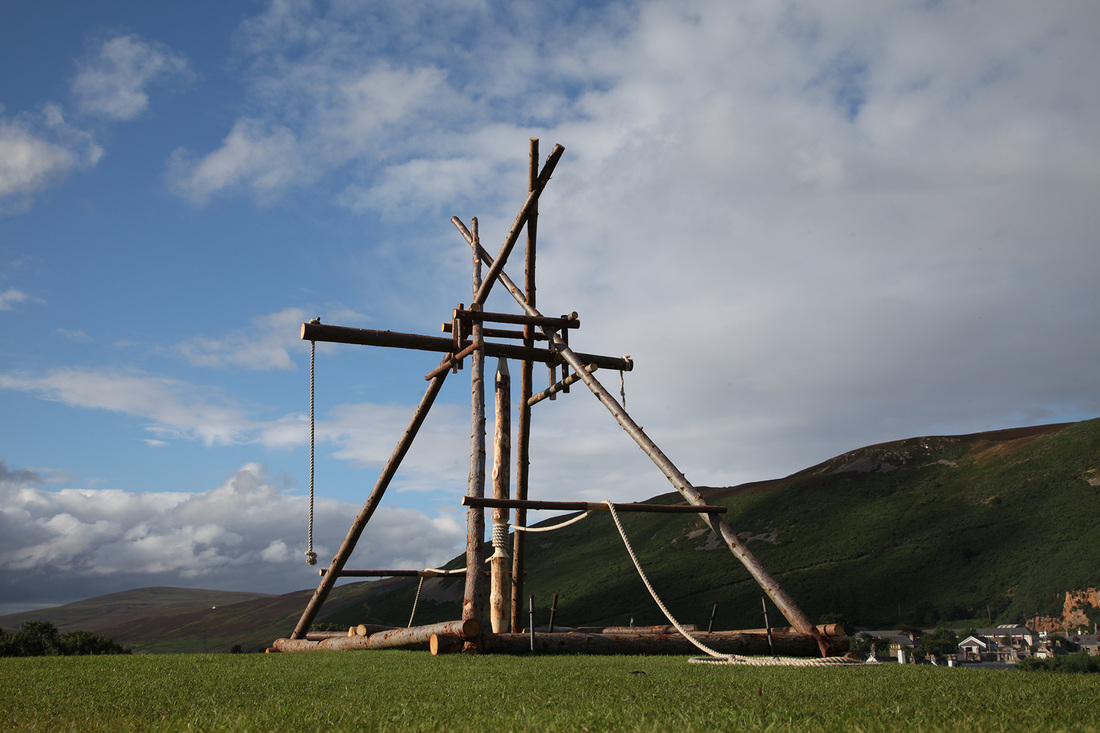
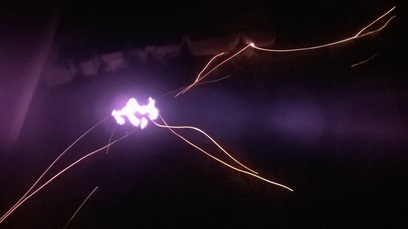
 RSS Feed
RSS Feed